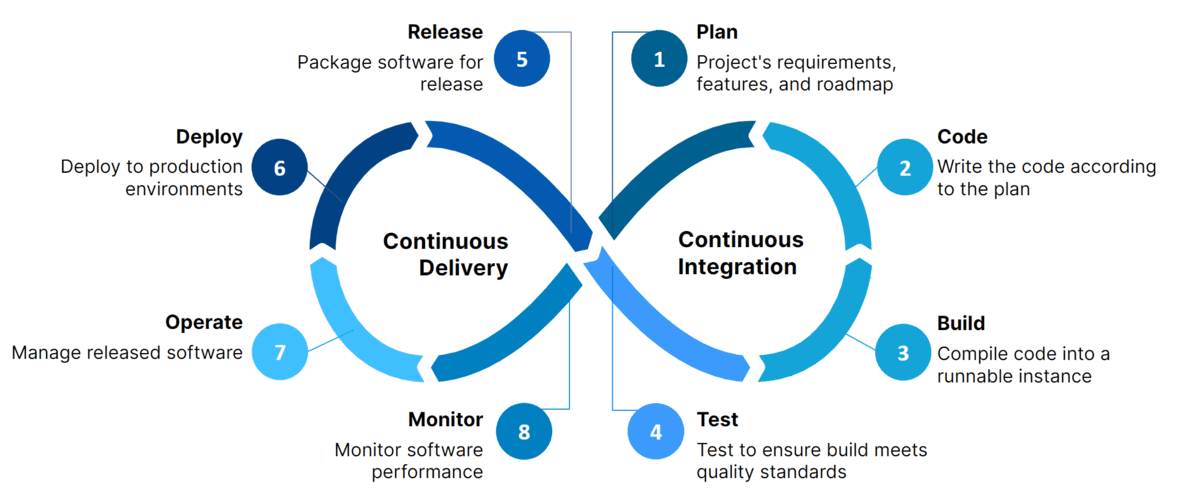In the competitive world of software development, companies must deliver high-quality products faster than ever before. As a result, meeting this demand requires an efficient way to develop, test, and deploy software. CI/CD pipelines (Continuous Integration and Continuous Deployment) automate the processes that traditionally take a lot of time and effort, thus helping teams achieve this goal.
CI/CD practices enable teams to continuously integrate code changes, run automated tests, and deploy new features with minimal manual intervention. By streamlining these processes, CI/CD accelerates workflows, reduces errors, and enables more consistent releases. In this blog, we’ll explore the basics of CI/CD pipelines, explain how they work, and discuss how your team can use them to improve the software delivery process.
What is CI/CD?
Before diving into how to use CI/CD pipelines, let’s first define what Continuous Integration and Continuous Deployment mean.
Continuous Integration (CI)
Continuous Integration refers to merging all developers’ working copies of code into a shared mainline (typically the main or master branch) several times a day. This practice emphasizes frequent integration of changes to avoid “integration hell,” where large changes accumulate, making it difficult to identify issues or bugs.
CI automates the process of building and testing software whenever changes are made, ensuring smooth integration and early detection of problems.
Key benefits of CI:
- Reduces integration problems by catching bugs early.
- Speeds up the development cycle by automatically testing and building code.
- Improves code quality by ensuring each change is tested and validated.
Continuous Deployment (CD)
Continuous Deployment (often interchanged with Continuous Delivery) automates the deployment process, taking CI a step further. Once the code passes all tests and checks, the system automatically deploys it to production without manual intervention.
This is the end goal of most CI/CD pipelines: automated delivery of new code, minimizing human error and enabling fast, continuous delivery of new features or fixes.
Key benefits of CD:
- Reduces manual intervention and the chance of human error.
- Speeds up the release cycle by automating deployment.
- Enables faster customer feedback, improving software quickly based on real-world use.
How to Build and Use CI/CD Pipelines
Building and using a CI/CD pipeline might seem daunting at first, but by breaking the process into manageable steps, you can create a streamlined approach. Below are the key components you need to build a robust pipeline.
Step 1: Set Up Version Control
Version control forms the backbone of any CI/CD pipeline. Most teams use tools like Git (with platforms such as GitHub, GitLab, or Bitbucket) to manage and track code changes. All team members should commit their code to a shared repository regularly.
- Version control system: Git
- Platforms to use: GitHub, GitLab, Bitbucket, etc.
Step 2: Set Up Automated Testing
A good CI/CD pipeline is only as effective as the tests it runs. Automated tests ensure that changes won’t break existing functionality. This typically includes:
- Unit tests: Check individual components or functions in isolation.
- Integration tests: Ensure different components of the system work together as expected.
- End-to-end tests: Validate the entire application in an environment mimicking real-world usage.
Integrating automated tests into your CI pipeline ensures that any change to the codebase is validated before it moves forward.
Step 3: Configure a Build Tool
Build tools compile and package your application (if applicable) and prepare it for deployment. Popular build tools include:
- Maven and Gradle for Java
- npm and Webpack for JavaScript
- Docker for containerized applications
Make sure your CI pipeline includes a build process that compiles and prepares the codebase for the next steps.
Step 4: Set Up a CI/CD Tool
Once your code is stored in a version control system and tests are configured, you’ll need a CI/CD tool to automate everything. Several tools are available for continuous integration and deployment, including:
- Jenkins: One of the most popular open-source CI/CD tools, known for its flexibility.
- CircleCI: A cloud-based CI/CD service that integrates well with popular version control systems.
- GitLab CI/CD: An integrated tool built into GitLab that offers robust CI/CD features.
- Travis CI: Popular among open-source projects, known for its simplicity and ease of integration with GitHub.
These tools monitor your code repository for changes, trigger automated builds and tests, and, if everything passes, deploy your code to the appropriate environment.
Step 5: Automate Deployment to Staging and Production
Once your code passes all tests, you can automatically deploy it to staging and production environments. Staging environments are replicas of production environments that allow you to test the final product before it reaches end-users.
A good practice is to deploy to staging first and only deploy to production if the staging deployment succeeds. This reduces the risk of bugs affecting users.
For deployment, you can use tools like:
- Kubernetes (for containerized applications)
- AWS CodePipeline (for Amazon Web Services)
- Azure DevOps (for projects hosted on Microsoft Azure)
- Google Cloud Build (for projects using Google Cloud)
These tools automate the deployment process and allow for rolling updates or blue-green deployments to reduce downtime.
Step 6: Monitor and Iterate
The final step in the CI/CD process is monitoring. Once your code is deployed to production, you’ll want to track its performance, error rates, and user feedback. Tools like Prometheus, Grafana, and Datadog are commonly used for monitoring applications in real-time.
If any issues arise in production, you can quickly roll back the changes using your CI/CD tool to minimize disruption.
Best Practices for Successful CI/CD Implementation
- Maintain a fast feedback loop: The goal of CI/CD is to catch issues early, so the quicker you receive feedback on changes, the better.
- Automate as much as possible: Automate builds, tests, deployments, and monitoring to reduce human errors.
- Run tests frequently: Run tests every time code is committed to avoid accumulating issues.
- Keep environments consistent: Use containerization (e.g., Docker) to ensure that your development, staging, and production environments are as similar as possible.
- Encourage small, frequent commits: Smaller changes are easier to review and debug. Commit changes regularly to avoid long periods between integration.
- Monitor your pipelines: Track pipeline performance and optimize for speed and reliability. Slow pipelines can hinder productivity.
Benefits of CI/CD Pipelines
By using CI/CD pipelines, teams can enjoy several benefits that directly impact their ability to deliver high-quality software quickly and reliably:
- Faster releases: CI/CD automates many manual processes, speeding up the release cycle and allowing for more frequent deployments.
- Higher quality: Automated testing ensures early detection of issues, improving the overall quality of the software.
- Reduced risk: Frequent, smaller changes reduce the risk of introducing large-scale issues into production.
- Enhanced collaboration: CI/CD encourages collaboration between development, testing, and operations teams, fostering a more cohesive workflow.
Conclusion
In conclusion, implementing a CI/CD pipeline is essential for modern software development. It enables teams to deliver new features and fixes faster, with more reliability and fewer bugs. By automating integration, testing, and deployment, CI/CD pipelines empower teams to focus on what truly matters—writing great code and delivering value to users.
The steps outlined in this blog provide a solid foundation for getting started with CI/CD. With the right tools and practices in place, your team can move toward continuous delivery and start reaping the benefits of faster, more reliable software delivery.place, your team can move towards continuous delivery and start reaping the benefits of faster, more reliable software delivery.




